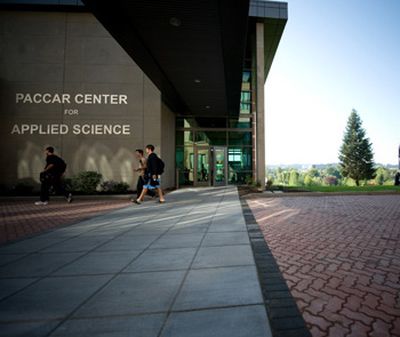New Gonzaga building receives Gold LEED certification
University’s PACCAR Center Hits its Mark

It’s not unusual for Gonzaga University to go for the gold. The prestigious school isn’t ranked in the top four West Coast colleges by U.S. News & World Report because it lacks ambition. Now Gonzaga is reaching for gold when it comes to its buildings as well.
The $8.5 million PACCAR Center for Engineering and Applied Science, Gonzaga’s first “green” structure, received the impressive Gold Certification from the Leadership in Energy and Environmental Design (LEED) rating system in July. Only the platinum ranking is a higher recognition in the LEED rating system, which was designed by the U.S. Green Building Council.
Although dedicated in 2008, the three-story, 29,000-square-foot building didn’t receive certification until just recently. The process is a lengthy one; however, it proved to be well worth the wait.
“Even though we were aiming for Gold Certification, we honestly didn’t think we would obtain that level,” said Engineering and Applied Science Dean Dennis Horn. “It’s due to the hard work of the ALSC architects that worked on the building and who did a thoroughly fantastic job. But the entire process was a real team effort by all who were involved.”
Located immediately south of the Herak Center for Engineering and Applied Science, the PACCAR Center houses sophisticated laboratories dedicated to robotics, artificial vision, and transmission and distribution line engineering, and is the first phase of a multi-phase project with anticipated expansions to the east and the west.
Mechanical and electrical engineering was handled by MW Consulting Engineers, while the project was overseen by general contractor Alan Douglas of Hoffman Contractors, both of Spokane.
Stephen Hindley, head architect for the Center, noted the significance of Horn’s driving force to the success of the project.
“The key to achieving LEED Gold certification is a committed client. Gonzaga University adopted Dean Horn’s vision for a new facility that embraced sustainable concepts and functioned as a demonstration site for the principles and technologies that the School of Engineering teaches,” he said in a GU release.
The LEED green building certification program encourages and accelerates global adoption of sustainable green building and development practices through a rating system that recognizes projects implementing strategies to optimize energy efficiency, minimize environmental impacts and enhance the experience of building users.
In addition to the sustainable aspects of the building, the site provides access to views and day lighting, promotes open public green space and provides opportunities to connect and extend the campus pedestrian system consistent with the campus master plan, said Hindley.
According to Ken Sammons, director of plant services at Gonzaga, “the project has reduced potable water use by over 34 percent, achieved an energy cost savings of approximately 30 percent and diverted 210 tons of on-site generated construction waste from landfill.”
In addition, a little over one-third of the total building materials used were manufactured using recycled materials, while about one-third of the resources were extracted, harvested, or recovered from within 500 miles of the project site.
Funding for the Center came largely from PACCAR, which Horn applauded for visionary leadership in providing the lead gift to build the Center. A global technology leader in the design, manufacture and customer support of freight trucks, PACCAR’s generous donations to community projects and organizations have spanned their operation of more than 100 years, recently earning them the recognition of “Washington State Philanthropic Company of the Year,” by the Washington Chapter of the Association of Fundraising Professionals.
Horn sees sustainable design as becoming an integral aspect of Gonzaga’s future expansion and hopes that the PACCAR Center is only the first of many green buildings to come on the campus.
“As future campus projects are considered, my hope is that they also may strive to use green engineering as an important component of their design.”